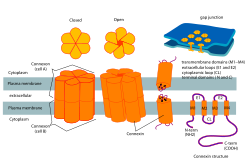| Connexon | |
|---|---|
 Connexon and connexin structure | |
| Details | |
| Identifiers | |
| Latin | connexona |
| TH | H1.00.01.1.02025 |
| Anatomical terminology | |
In biology, a connexon, also known as a connexin hemichannel, is an assembly of six proteins called connexins that form the pore for a gap junction between the cytoplasm of two adjacent cells. This channel allows for bidirectional flow of ions and signaling molecules.[1] The connexon is the hemichannel supplied by a cell on one side of the junction; two connexons from opposing cells normally come together to form the complete intercellular gap junction channel. In some cells, the hemichannel itself is active as a conduit between the cytoplasm and the extracellular space, allowing the transference of ions and small molecules lower than 1-2 KDa. Little is known about this function of connexons besides the new evidence suggesting their key role in intracellular signaling.[2] In still other cells connexons have been shown to occur in mitochondrial membranes and appear to play a role in heart ischaemia.[3]
Connexons made of the same type of connexins are considered homomeric, while connexons made of differing types of connexins are heteromeric.[4]
- ^ Cheung, Giselle; Chever, Oana; Rouach, Nathalie (2014-11-04). "Connexons and Pannexons: Newcomers in Neurophysiology". Frontiers in Cellular Neuroscience. 8: 348. doi:10.3389/fncel.2014.00348. PMC 4219455. PMID 25408635.
- ^ Cite error: The named reference
Hervewas invoked but never defined (see the help page). - ^ Ruiz-Meana, M.; Rodríguez-Sinovas, A.; Cabestrero, A.; Boengler, K.; Heusch, G.; Garcia-Dorado, D. (2008). "Mitochondrial connexin43 as a new player in the pathophysiology of myocardial ischaemia-reperfusion injury". Cardiovascular Research. 77 (2): 325–333. doi:10.1093/cvr/cvm062. PMID 18006437.
- ^ Wright, Josephine; Richards, Toby; Becker, David (2012-03-01). "Connexins And Diabetes". Cardiology Research and Practice. 2012: 496904. doi:10.1155/2012/496904. PMC 3303578. PMID 22536530.